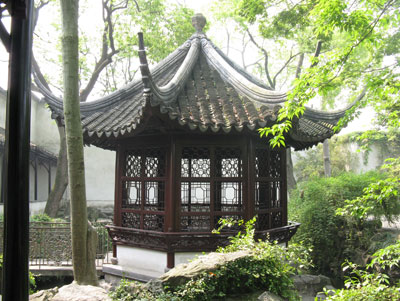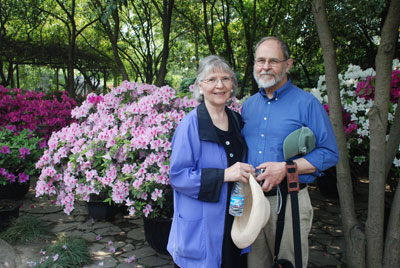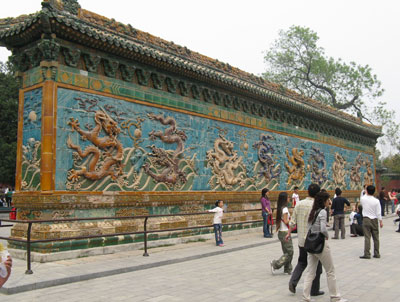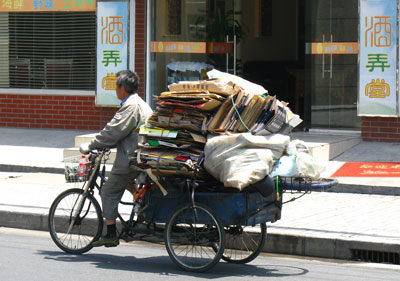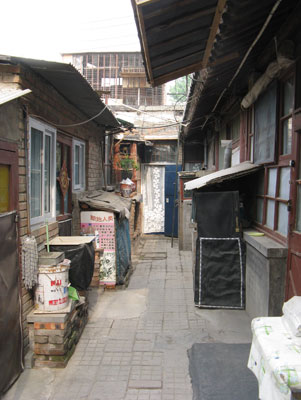Visiting friends in China — hitting the highlights, with a local’s insight
by Marisue Pickering, Orono, ME. Photos by John W. Pickering
In late April/early May ’08, my husband, John, and I were the guests of a Chinese couple who had lived with us for a year in the early 1990s, when they were in the United States as students. Now well established in the man’s home city of Shanghai, our friends provided us with round-trip air tickets and organized a visit that included time in Beijing, Shanghai, Suzhou and Hangzhou.
Our friends
Our friends, Shimbiao and Li, live with their 7-year-old son in a community of townhouses in a recently developed suburb of Shanghai. Shimbiao works for a US-based company in China that makes automotive components. Li manages a small family company and cares for their son and oversees his schooling.
Shimbiao and Li dedicated almost two weeks to our visit, having us as houseguests and taking us to traditional tourist sites as well as to places they thought would especially interest us.
Beijing
We spent three days in Beijing over the May Day holiday, a time of major travel for the Chinese. We had reservations on the 12-hour overnight Shanghai-Beijing train. Shimbiao and Li gave my husband and me the lower bunks, and they — a generation younger and more agile! — took the two uppers with their son.
Our small, shared compartment was exceedingly comfortable and even came with a fresh flower on the small table, individual reading lights and slippers for each person. We slept very well, enjoying going to sleep to the clickity-clack of a moving train — something I had not done for many decades.
Shimbiao and Li have a flat in Beijing, Li’s hometown, which is where they stayed. They treated us to a hotel located only a few blocks from the north entrance of the Forbidden City. We had a spacious and comfortable room overlooking courtyard homes and the National Art Gallery.
Imperial city sights
Our time in Beijing was devoted to three major imperial attractions: BeiHai Park, the Summer Palace and the Forbidden City. BeiHai Park, named on China’s World Heritage Tentative List, is considered China’s oldest-existing imperial garden. Located at the northwest corner of the Forbidden City, it seemed a place little visited by Westerners but thoroughly enjoyed by Chinese of all ages.
Created in the 10th century, BeiHai Park covers about 170 acres and consists of beautiful pavilions, temples, gardens and a good-sized lake.
At one pavilion, a group of retirees from a particular work unit had gathered to visit and sing songs. Once they realized we were listening, we became their audience — a real treat.
A highlight of the Summer Palace, once a place of retreat for the imperial family and now a UNESCO World Heritage Site, was the famous Marble Boat associated with China’s Dowager Empress Cixi (1835-1908). Again, we were impressed with how many Chinese were enjoying the marvelous grounds, located in the northwest section of the city about eight miles from the Forbidden City. In one of the courtyards, a group of older women was participating in a line dancing class!
Because of rain, we spent our day in the Forbidden City, another World Heritage Site, primarily inside its exhibition halls viewing magnificent imperial treasures. We would particularly recommend the Hall of Clocks and Watches, a place to see extravagant timepieces presented to China’s imperial rulers by foreign envoys.
Hutongs
Beijing is well known for its hutongs, lanes connecting traditional courtyard residences. Twenty years ago when they were newly married, Shimbiao and Li lived in a courtyard flat, to which they took us one evening. Although many courtyard homes have been demolished, theirs remains, and we had the opportunity to walk through this traditional housing of a type popular before the prevalence of highrise apartments.
Shanghai
Returning to Shanghai, we found the city an interesting blend of different eras. Because of its mesmerizing architecture, new subways and train stations, omnipresent construction and the aura of urban busyness, Shanghai seems a city firmly planted in the 21st century. It also seems a city determined to make itself work for its 18 million-plus inhabitants.
We were especially taken with the comfort and efficiency of the ultramodern subways as well as the fact that they were filled with people. By the end of our first day on the subway, we were sure we had been in the midst of more people than live in our entire state of 1.2 million!
In the 19th century, Western powers forced China to open Shanghai (and other cities) to foreign trade and allow Western settlement in choice places. Those European connections are still evident in Shanghai.
We visited the French Concession, now an area that includes lovely restaurants, old sycamore trees and upscale shops. We spent a rainy evening there appreciating the area’s blend of Western and Chinese influences and visiting the nongtang (alley housing) where Shimbiao grew up. His home had since been torn down, but the area recently was placed on the Historical Preservation Register, thus preventing further destruction and preserving this style of traditional Shanghai housing.
We were particularly pleased to see the famous Bund, the 1.2-mile section of Shanghai’s river embankment lined with European-style buildings, many of which were constructed in the early decades of the 20th century for purposes of trade and banking. There, as well as in the French Concession, we were reminded of Western imperialism and its impositions on China, but that uncomfortable reminder was mixed with our enjoyment of the sheer beauty of the Bund’s Neo-Classical and Art Deco buildings.
Shanghai Museum
Located in Shanghai’s center, where the old European racecourse had been and where all subway lines now converge, is People’s Square, well tended, filled with flowers and surrounded by new buildings. In the middle of the square is the elegant Shanghai Museum.
The museum itself is architecturally creative, designed in the shape of a traditional Chinese round cooking pot, complete with handles. We spent most of our time in the bronze and ceramic galleries learning about the development of bronzes and ceramics, from their utilitarian beginnings to their modern forms. We highly recommend this world-class museum.
Suzhou, the Garden City
Because our friends knew of my husband’s interest in gardens, they organized a day trip to Suzhou, about an hour’s drive from their Shanghai home. (The travel time depends on the hard-to-believe-until-you-have-been-in-it traffic on the motorway.)
Suzhou, a World Heritage Site, is renowned for its gardens, considered masterpieces of classical design. We visited what is described as “one of the four most famous gardens in China,” the Humble Administrator’s Garden. This area of almost 13 acres, created by a retired government official in the early 1500s, was lovely and tranquil.
We walked along winding paths, enjoying the beauty of pavilions, caged birds, azaleas in bloom and rock formations. Although we encountered a number of other visitors, the design of the garden meant it never felt crowded.
Hangzhou
Hangzhou is another city known for its scenic beauty, including its large West Lake. It is the lake, and its “scenic zone,” that has placed Hangzhou on the World Heritage Tentative List.
Hangzhou was a train trip of about one hour and 40 minutes from Shanghai. We needed advance train reservations, as the city is a popular destination for biking, boating, walking and generally having a relaxing time.
Incidentally, after a few days in Shanghai, my husband and I felt we could manage a bit on our own, but that feeling didn’t extend to traveling to Hangzhou. The train stations in both Shanghai and Hangzhou are huge and packed with people, and Hangzhou’s signage was confusing. Construction around Hangzhou’s train station complicated matters.
We were most appreciative for Li, as were two French tourists we “picked up,” people who had tried to go to Hangzhou on their own. They ended up spending the day with us, continually expressing their appreciation to Li for her help.
Impressions
During our stay in China, we traveled with our friends on subways and trains and were quite taken with the quiet, nonaggressive movement of people. We also frequently took buses, which gave us the opportunity to go through a variety of neighborhoods, giving us a lasting impression of the blend of the traditional and the new in the cities we visited.
We ate out a lot, at places ranging from neighborhood restaurants to an upscale restaurant in a health club, and enjoyed them all. As vegetarians, we feasted on a variety of unknown vegetables, new types of white rice and mysterious mushrooms. During our single excursion to a restaurant on our own, my husband and I did quite well ordering with the help of a guidebook and a bit of Mandarin, which we had studied somewhat before we left home.
We highly recommend the one hotel we stayed in, Beijing’s 4-star Kang Ming Hotel (No. 18, Meishuguan Hou Jie, Dongcheng District; phone [8610] 64023388, www.kangminghotel.com).
Our business-class air travel was courtesy of Shimbiao’s Star Alliance frequent-flyer miles. Going to China, we traveled on United from Portland, Maine, to Chicago, continuing on to Shanghai on the 5-star Asiana Airlines. On board Asiana, the service was extraordinary, the food quite good, the seats truly comfortable and our cabin spotless, and the airport lounges were a treat. Coming home, we were on 3-star United all the way. Our preference is Asiana.
We were very touched by this major gift from our friends. To live with them for almost two weeks and to see China as their guests was a wonderful and unique experience.


